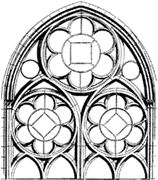
Rose windows derive their name from their shape, which is round and made up of petal-like forms radiating from a central point. Adorned with stained glass, they first appeared in Gothic cathedrals and churches of the 12th century, such as the Cathedral of Notre Dame de Paris (begun 1163; see Gothic Art and Architecture). Large windows ranging from 9 to 12 m (30 to 40 ft) in diameter were placed on the western façades of the buildings; smaller windows were used at the ends of the north and south transepts. The windows symbolize the Virgin Mary, whose flower is a rose.
In early rose windows the glass was supported by plate tracery with the design pierced in the stone. Later, more flexible bar tracery was used, with bars built up on the arch principle and thus not wholly dependent on the walls for support. The glass in nearly all rose windows is arranged in a nonrepresentational design, with colors arranged for the sake of a unified decorative effect. By the late 1300s, rose windows in the flamboyant style (with flamelike tracery) began to appear, as in the north rose (late 1400s) of the Cathedral of Saint-Etienne at Sens, France.